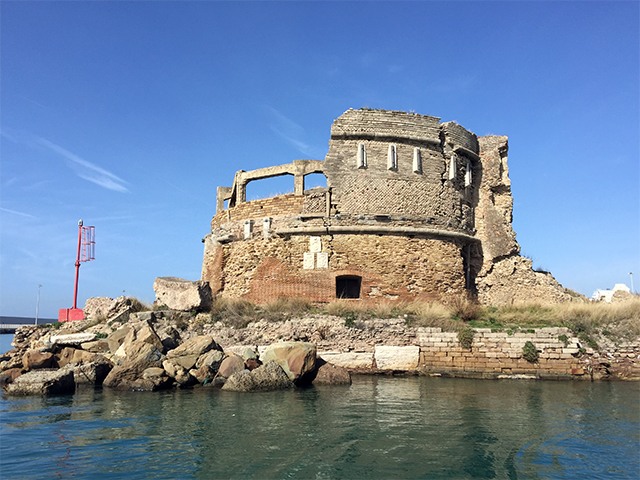Port of Civitavecchia: in search for the lost treasure
What does the sea bottom of the port hide? Is the legend about the statue of Neptune true? Is there actually a hidden treasure? Soon the truth will come to light. How and whySOME COMMENTS BEFORE READING THE ARTICLE
- the iniciative of the submarine search is originally born with the aim to supervise the substructures of the Lazzaretto. There is, then, an objective of security and safeguard;
- at the moment the idea has positively been accepted verbally by the Coastguard, and we give our approval to that, but no agreement has yet been closed nor signed, since amministrative procedures involve, rightly, the involvement of the Goverment Department responsible for Cultural Heritage.
- if, and we insist on the if, the project should be approved by all the parts involved -Coastguard and Superintendence, authorities and Port Authorities- it can be assumed that the exploration would be "expanded" into the Roman Harbour.
At the moment there are no official agreements, the project is at an early stage.
Port of Civitavecchia, January, 27 2016
The first underwater monitoring at the Port of Civitavecchia are very likely to start very soon! The news are sensational.
Today we spoke to Mario Palmieri, founder and curator of the exhibition Navalia, and he kindly explained that the Coastguard has given their consent, for now only verbal to collaborate on "reconnaissance underwater observation".
Let's therefore make the compliments to CANS (Archaeological Center for Naval Studies) who have, together with the association La Civetta di Civitavecchia, strongly wanted and proposed this project. It is our hope that the Coast Guard and the Superintendence for Cultural Heritage will succeed in finding the agreement to start the work. To learn more about the arguments of diving recognitions and of potability of the Roman aqueduct in Civitavecchia please click here: Lazzaretto, Roman Harbour and aqueduct (Italian).
"Today I met with Counter Admiral Giuseppe Tarzia to whom I asked the possibilty to conclude diving surveys around the Lazzaretto in order to check the state of the building. He expressed his intention to cooperate supplying qualified personnel. I also asked for the possibility to make surveys also in the area of the Harbour and, also in this case, he gave a positive answer".
Commander Mario Palmieri, 22/01/2016

What does the sea bottom of the port hide?
WHY MONITORING THE SEA BOTTOM
But why is it so important to monitor the seabed of the port? Certainly, at least initially, for a security issue. Yes, because the area that will be monitored is that around the Lazzaretto, frighteningly bombed during the Second World War. It then becomes essential for public safety and the safety of operators and entities who organize events and manifestations in this particular area to work inside or close to a solid and secure structure.
It will be interesting to try to understand if in the depths of the port of Civitavecchia hides really that legendary treasure that everyone is talking about but nobody has ever managed to find. We speak of shipwrecks, historical objects, archaeological finds that, for the most varied reasons, have been "lost" in this sea during the 2000 years of life of the port of Rome. We refer in particular to the mythological story of the statue of Neptune as the dozens of wrecks which is said can be hidden under the seabed.
Another interesting chapter of the research will concern the conduct of drinking water recently discovered inside the premises of the Naval service and that potentially could supply the entire city of Civitavecchia!
To learn more about this topics read this article about the reopening of Navalia and this about the 10 things you don't know about the port.

It is said that the sea bottom of the port of Civitavecchia might hide over 15 wreckage of ships from the old Roman fleet
COME AVVERRANNO I MONITORAGGI
Once an agreement has been reached between the Coast Guard and the Superintendence, the search will cover the entire area of the Lazzaretto and subsequently, if the parties concerned find it advisable, may also affect the Roman Harbour. In order to facilitate the daily work of ships, means and vessels monitoring will be carried out for zones, coordinated by the Coastguard in cooperation with the Superintendence that will suggest areas that, in turn, may be inspected. Operatively, the divers of underwater core, accredited by the Superintendence of ASSO will dive and film in the waters of the harbor. Presumably, they will be "escorted" and coordinated by the underwater group of Coastguard.
The whole first phase of the diving recognitions will be carried out through video footage that will serve to see, study and evaluate the conditions of the substructures of the Lazzaretto. Afterwards, if the Superintendency will go forward in the search and there will be the conditions, they can proceed to works of operational analysis and research of any findings and historical objects that might be hidden.
Will the legend become true? We can only wish the whole research team a good job and wait patiently for the results of the first dives.



 PORT MOBILITY CIVITAVECCHIA
PORT MOBILITY CIVITAVECCHIA


















